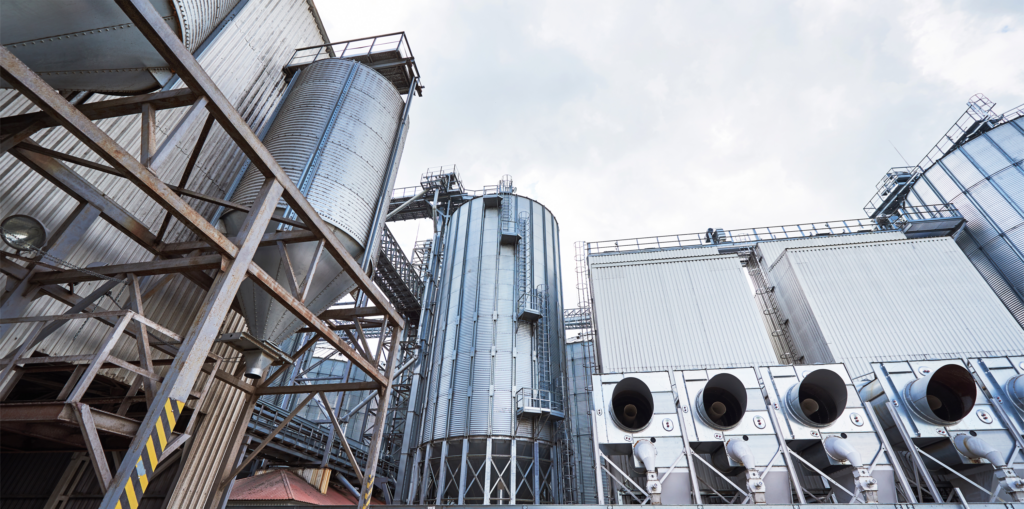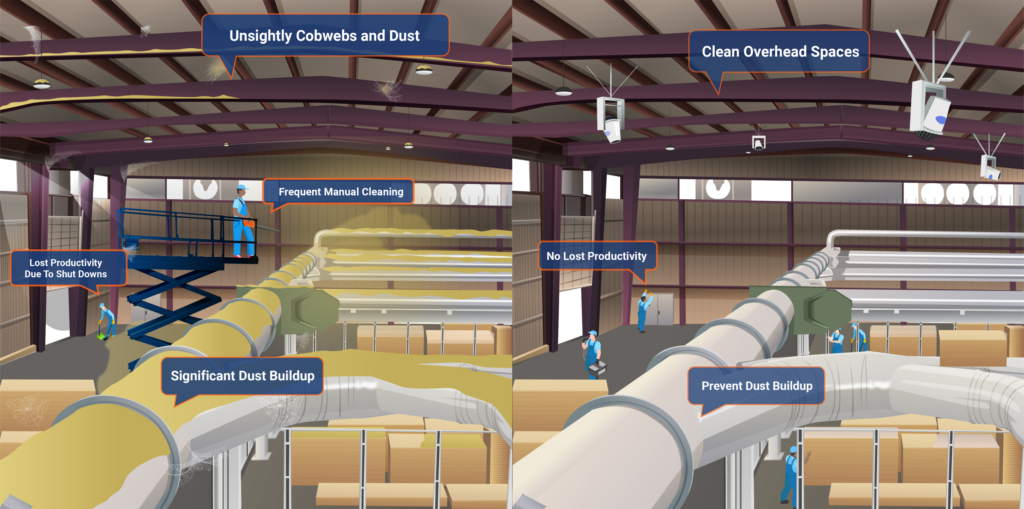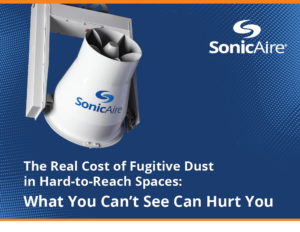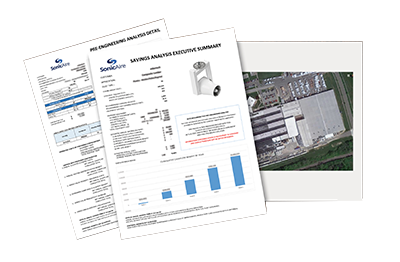A dust particle—it’s such a small thing.
At first glance, it might seem altogether unremarkable and insignificant, perhaps not even worth the space it takes to write about. But nothing could be further from the truth.
Dust isn’t necessarily the first villain that comes to mind as an impediment to workflow and employee satisfaction. But in the context of many production facilities, this tiny enemy has a huge and potentially dangerous impact.

SonicAire supports a variety of industries, including plastics, bulk powders, grain, laundry, and more. But, to illustrate our point, we want you to imagine two wood product facilities: the run-of-the-mill and the state-of-the-art.
The Run-of-the-Mill Facility
There are many ways that the run-of-the-mill facility has kept up with the times. For example, they use high-efficiency machines, which get the most from each piece of timber and create less waste in the process. This enables them to maximize production. But they haven’t kept up with the times with their sawdust removal process. Instead, they continue to rely on so-called “tried and true” methods to manage dust as best as they can.
Like any other wood product facility, they know well that sawdust, and lots of it, is a given. And they know that sawdust removal is critical because as dust accumulates, especially in those out-of-sight and hard-to-reach areas, the threat of a catastrophic event increases. So they attempt to prevent dust from settling by capturing as much as possible at the source itself. However, they haven’t considered that their high-efficiency machines make dust control exponentially more complex and practically demand an overhaul in their cleanup process.

What they gain in efficiency, they inadvertently lose in risk reduction. That’s simply because the byproduct of less wood waste is much finer dust particles than before. And without a more effective dust removal process, the run-of-the-mill facility and its employees face three significant problems.
1. Conventional dust removal methods require workflow interruptions.
The run-of-the-mill facility must manually clean the workspace, including support beams and ductwork. As a result, they’ve got to push pause on productivity. There’s no way around it. It simply takes time, and lots of it, to access those hard-to-reach spots that are prone to buildup. But at the end of the day, all that fuss only generates sub-par results and higher costs.
On top of that, the ultra-fine sawdust that their newer equipment produces requires A LOT more effort to remove. That means that manual cleaning not only demands they hit the brakes on production but also requires them to do it for much longer than in previous eras. And even then, the results are usually questionable.
2. Conventional dust removal methods are unreliable.
All the fine dust makes an effective manual cleaning near impossible. At best, the run-of-the-mill facility will remove some unwanted combustible materials, but they’ll ultimately redirect the rest to settle down in a new spot. What’s worse is that the act of manual cleaning only aids the delusion of employee safety.
The reality, however, is quite scary. According to the U.S. Chemical Safety Board, between 2006 and 2017, 111 combustible dust incidents caused 337 injuries and 66 fatalities. These numbers are strikingly high, especially given the mitigative technology we have at our disposal today. For instance, SonicAire’s solutions stop dust build up in its tracks. In other words, they help make these kinds of alarming numbers a thing of the past.
3. Unreliable dust removal has a direct impact on employee satisfaction.
The psychological impact of working in a high-dust environment with ineffective and unreliable cleaning measures in place can’t be understated. This is especially true in the era of the Great Resignation. Recent research shows that an average of 3.9 million people per month quit their jobs in 2021. And, the leading risk factor associated with employee turnover? Disengagement. In fact, according to Gallup, “the highest quit rate is among not engaged and actively disengaged workers.” This research suggests that anything threatening employee engagement can potentially derail retention efforts.
So to help reduce high turnover, employers need to create a workspace that reignites employee engagement. And it isn’t just that clean spaces feel nice and give us the mental boost we need. In fact, that misses the more significant issue altogether. No matter the material, dust accumulation increases employee risk, and employees know it. Alongside the danger of combustion remains the threat of toxicity due to high degrees of exposure, and no respirator is 100% foolproof.
Translation: your workforce needs to feel safe from immediate hazards as well as from the long-term implications of dust exposure. With their current ineffective dust removal process, the run-of-the-mill facility completely misses the mark on this point, and their dissatisfied employees are now on the fast track toward burnout.
So, what’s the takeaway here? If you want to decrease workflow interruptions, mitigate employee risk, and improve employee satisfaction and engagement, then it’s high time you dropped the old, worn-out dust removal methods. It’s the best way to maximize profitability.
To drill this point in, let’s take a look at another facility, one that gets it right.

The State-of-the-Art Facility
The state-of-the-art facility isn’t messing around. They’ve kept with the times in every respect. Not only do they create less waste by using better quality, highly efficient machines, but they’ve also wholly transformed their dust removal process. They realize that innovations are required across the board to significantly reduce the risk of dust-combustion incidents and save time and money in the process. Yes, it was an investment upfront, but the ROI has been so significant that it was well worth it.
Most importantly, what the run-of-the-mill facility lost because of its unwillingness to allow its dust removal process to evolve, the state-of-the-art facility gained.
1. They’ve eliminated workflow interruptions.
Using SonicAire’s BarrierAire® technology, they’ve simplified the cleaning process. By continuously preventing fugitive dust from settling in hard-to-reach places in the first place, the state-of-the-art facility no longer needs to worry about potentially dangerous buildup over time. That also means they won’t need to get a lift to aid the cleaning process and, therefore, won’t have to halt production.
It all boils down to this: the state-of-the-art facility focuses on prevention and protects its employees and assets while reducing costs and risks associated with manual cleaning.
2. Dust removal is now a streamlined and reliable process.
Prevention packs a punch here. Since dust is continually being removed, frequent overhead manual cleaning (which is far less effective) isn’t even necessary. This is so important because, in wood product industries, super-fine and dry dust (we’re talking about dust containing less than 3% water) is nearly as combustible as gasoline.
And again, the ROI is huge: fewer combustible dust incidents and reduced costs associated with less reliable removal processes.
3. Employees feel safer and are more engaged than ever before.
There are significant psychological benefits to not only feeling safer but knowing that you are. you’re safer are significant. And while feeling safe doesn’t automatically catalyze employee engagement, it does remove one of its biggest roadblocks. When employees no longer have to worry about the risks that underlie their daily routine, they can mentally invest in their work.
By leveraging the power of effective preventative measures, the state-of-the-art facility takes charge of ensuring employee satisfaction, deepens employee engagement, and helps reduce turnover.
SonicAire is the global leader in overhead dust mitigation. Don’t be run-of-the-mill. Partner with us and we’ll design effective, customizable fan control systems to fit your specific facility needs.
Schedule a Free Consultation Today

A dust particle—it’s such a small thing. At first glance, it might seem altogether unremarkable and insignificant, perhaps not even worth the space it takes to write about. But nothing could be further from the truth.
Dust isn’t necessarily the first villain that comes to mind as an impediment to workflow and employee satisfaction. But in the context of many production facilities, this tiny enemy has a huge and potentially dangerous impact.
SonicAire supports a variety of industries, including plastics, bulk powders, grain, laundry, and more. But, to illustrate our point, we want you to imagine two wood product facilities: the run-of-the-mill and the state-of-the-art.
The Run-of-the-Mill Facility
There are many ways that the run-of-the-mill facility has kept up with the times. For example, they use high-efficiency machines, which get the most from each piece of timber and create less waste in the process. This enables them to maximize production. But they haven’t kept up with the times with their sawdust removal process. Instead, they continue to rely on so-called “tried and true” methods to manage dust as best as they can.
Like any other wood product facility, they know well that sawdust, and lots of it, is a given. And they know that sawdust removal is critical because as dust accumulates, especially in those out-of-sight and hard-to-reach areas, the threat of a catastrophic event increases. So they attempt to prevent dust from settling by capturing as much as possible at the source itself. However, they haven’t considered that their high-efficiency machines make dust control exponentially more complex and practically demand an overhaul in their cleanup process.

What they gain in efficiency, they inadvertently lose in risk reduction. That’s simply because the byproduct of less wood waste is much finer dust particles than before. And without a more effective dust removal process, the run-of-the-mill facility and its employees face three significant problems.
1. Conventional dust removal methods require workflow interruptions.
The run-of-the-mill facility must manually clean the workspace, including support beams and ductwork. As a result, they’ve got to push pause on productivity. There’s no way around it. It simply takes time, and lots of it, to access those hard-to-reach spots that are prone to buildup. But at the end of the day, all that fuss only generates sub-par results and higher costs.
On top of that, the ultra-fine sawdust that their newer equipment produces requires A LOT more effort to remove. That means that manual cleaning not only demands they hit the brakes on production but also requires them to do it for much longer than in previous eras. And even then, the results are usually questionable.
2. Conventional dust removal methods are unreliable.
All the fine dust makes an effective manual cleaning near impossible. At best, the run-of-the-mill facility will remove some unwanted combustible materials, but they’ll ultimately redirect the rest to settle down in a new spot. What’s worse is that the act of manual cleaning only aids the delusion of employee safety.
The reality, however, is quite scary. According to the U.S. Chemical Safety Board, between 2006 and 2017, 111 combustible dust incidents caused 337 injuries and 66 fatalities. These numbers are strikingly high, especially given the mitigative technology we have at our disposal today. For instance, SonicAire’s solutions stop dust build up in its tracks. In other words, they help make these kinds of alarming numbers a thing of the past.
3. Unreliable dust removal has a direct impact on employee satisfaction.
The psychological impact of working in a high-dust environment with ineffective and unreliable cleaning measures in place can’t be understated. This is especially true in the era of the Great Resignation. Recent research shows that an average of 3.9 million people per month quit their jobs in 2021. And, the leading risk factor associated with employee turnover? Disengagement. In fact, according to Gallup, “the highest quit rate is among not engaged and actively disengaged workers.” This research suggests that anything threatening employee engagement can potentially derail retention efforts.
So to help reduce high turnover, employers need to create a workspace that reignites employee engagement. And it isn’t just that clean spaces feel nice and give us the mental boost we need. In fact, that misses the more significant issue altogether. No matter the material, dust accumulation increases employee risk, and employees know it. Alongside the danger of combustion remains the threat of toxicity due to high degrees of exposure, and no respirator is 100% foolproof.
Translation: your workforce needs to feel safe from immediate hazards as well as from the long-term implications of dust exposure. With their current ineffective dust removal process, the run-of-the-mill facility completely misses the mark on this point, and their dissatisfied employees are now on the fast track toward burnout.
So, what’s the takeaway here? If you want to decrease workflow interruptions, mitigate employee risk, and improve employee satisfaction and engagement, then it’s high time you dropped the old, worn-out dust removal methods. It’s the best way to maximize profitability.
To drill this point in, let’s take a look at another facility, one that gets it right.

The State-of-the-Art Facility
The state-of-the-art facility isn’t messing around. They’ve kept with the times in every respect. Not only do they create less waste by using better quality, highly efficient machines, but they’ve also wholly transformed their dust removal process. They realize that innovations are required across the board to significantly reduce the risk of dust-combustion incidents and save time and money in the process. Yes, it was an investment upfront, but the ROI has been so significant that it was well worth it.
Most importantly, what the run-of-the-mill facility lost because of its unwillingness to allow its dust removal process to evolve, the state-of-the-art facility gained.
1. They’ve eliminated workflow interruptions.
Using SonicAire’s BarrierAire® technology, they’ve simplified the cleaning process. By continuously preventing fugitive dust from settling in hard-to-reach places in the first place, the state-of-the-art facility no longer needs to worry about potentially dangerous buildup over time. That also means they won’t need to get a lift to aid the cleaning process and, therefore, won’t have to halt production.
It all boils down to this: the state-of-the-art facility focuses on prevention and protects its employees and assets while reducing costs and risks associated with manual cleaning.
2. Dust removal is now a streamlined and reliable process.
Prevention packs a punch here. Since dust is continually being removed, frequent overhead manual cleaning (which is far less effective) isn’t even necessary. This is so important because, in wood product industries, super-fine and dry dust (we’re talking about dust containing less than 3% water) is nearly as combustible as gasoline.
And again, the ROI is huge: fewer combustible dust incidents and reduced costs associated with less reliable removal processes.
3. Employees feel safer and are more engaged than ever before.
There are significant psychological benefits to not only feeling safer but knowing that you are. you’re safer are significant. And while feeling safe doesn’t automatically catalyze employee engagement, it does remove one of its biggest roadblocks. When employees no longer have to worry about the risks that underlie their daily routine, they can mentally invest in their work.
By leveraging the power of effective preventative measures, the state-of-the-art facility takes charge of ensuring employee satisfaction, deepens employee engagement, and helps reduce turnover.
SonicAire is the global leader in overhead dust mitigation. Don’t be run-of-the-mill. Partner with us and we’ll design effective, customizable fan control systems to fit your specific facility needs.
Schedule a Free Consultation Today

GET YOUR FREE GUIDE:
The Real Cost of Fugitive Dust in Hard-to-Reach Spaces
What You Can’t See Can Hurt You
To help protect your workplace, we’ve compiled the following resource, The Real Cost of Fugitive Dust in Hard-to-Reach Spaces: What You Can’t See Can Hurt You. In it, we identify seven ways fugitive dust is likely impacting your facility and its profitability.
These costs go beyond housekeeping and explain why you should be preventing dust buildup to protect the bottom line, not just to stay in compliance.

